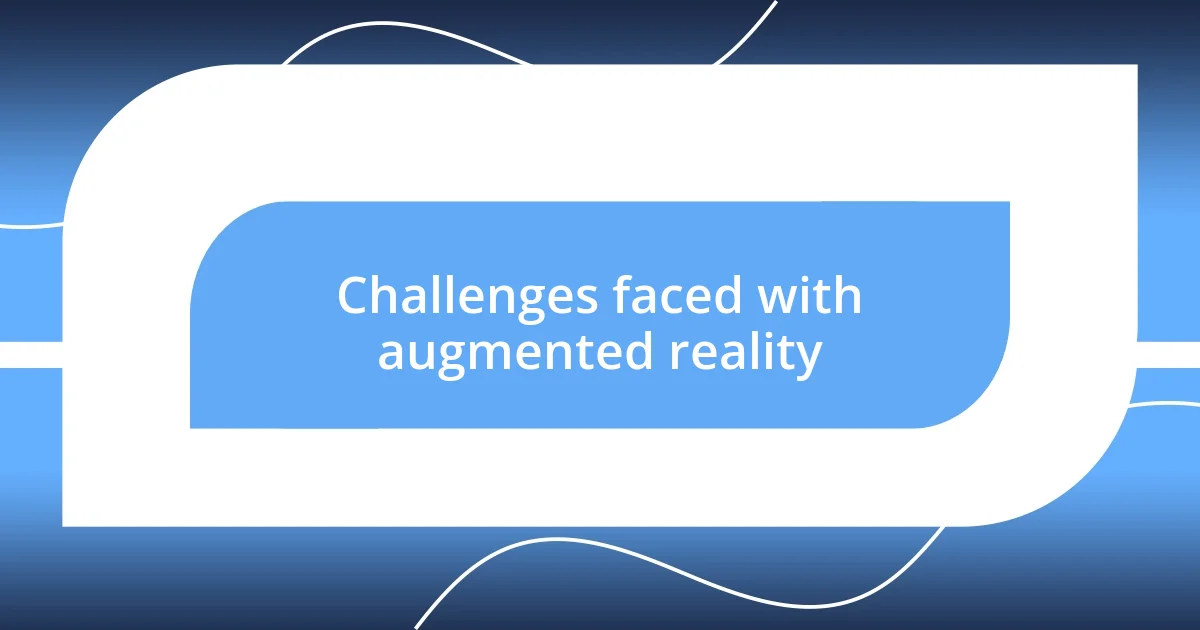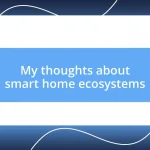Key takeaways:
- Augmented Reality (AR) apps enhance everyday experiences by blending digital content with the physical environment, fostering engagement and understanding.
- Key benefits of AR include improved learning, increased engagement, better decision-making, social interaction, and real-time assistance in various fields.
- Challenges faced in AR development include synchronization issues, complex user experiences, and limitations based on device compatibility, highlighting the need for intuitive design and broader accessibility.

Understanding augmented reality apps
Augmented reality (AR) apps blend the digital world with our physical environment, creating a unique and interactive experience. I remember the first time I used an AR app to visualize how furniture would look in my living room. It was incredible! I could move around my space and see exactly how different pieces fit, making the decision-making process so much easier and more enjoyable.
What fascinates me about AR apps is their ability to transform everyday activities. I once used an AR app while hiking; it provided real-time information about the trails and even highlighted points of interest along the way. I couldn’t help but wonder: How often do we miss the beauty of our surroundings because we lack context? AR not only informs but also enhances our appreciation of the world.
When diving into AR, I find that the potential uses are nearly limitless. From education to gaming, the technology captivates users by making abstract concepts tangible. For instance, I once played an AR game that superimposed animated creatures onto real-world surfaces. As I chased them around, it felt like my mundane living room had transformed into a vibrant, enchanted forest! Through these experiences, I gained a true understanding of AR’s power to create connections between our digital desires and physical reality.

Benefits of augmented reality experiences
The benefits of augmented reality experiences are profound and can change how we interact with both digital content and the real world. I remember attending a virtual museum tour through an AR app that brought history alive in a way I had never imagined. I could walk around sculptures that spun and glimmered in my living room, making me feel like I was actually there! It’s amazing how AR bridges the gap between learning and engagement, transforming mundane experiences into something memorable.
Here are some key benefits I’ve noticed:
- Enhanced Learning: AR turns complex subjects into visual and interactive experiences, making it easier to grasp new concepts.
- Increased Engagement: By layering digital information onto the physical world, AR makes activities, like shopping or exploring nature, far more exciting.
- Improved Decision-Making: Apps that allow visualization, such as trying on clothes or seeing furniture in real rooms, help eliminate uncertainty when making choices.
- Social Interaction: Many AR experiences can be shared with friends, creating unique social moments even from a distance.
- Real-Time Assistance: In fields like medicine or automotive repair, AR offers visual guides that enhance efficiency and accuracy, saving time and reducing errors.
Reflecting on these benefits, I can truly appreciate how augmented reality enhances our everyday activities in surprising ways. Each experience feels uniquely tailored to help us interact with our environment.

My favorite augmented reality features
My favorite augmented reality features really highlight the innovative ways this technology can enhance our day-to-day experiences. One standout feature for me is object recognition, where an app identifies real-world items and provides pertinent information about them. I vividly recall walking through a botanical garden using an AR app that allowed me to point my phone at different plants. Suddenly, I was flooded with details about their origins and uses, almost like having a guide right by my side, which deepened my appreciation for nature.
Another feature I find thrilling is 3D modeling. I once used an AR app for a DIY project, allowing me to visualize how various upgrades would look in my home before making any changes. It felt empowering to see my ideas come to life in three dimensions; I could easily rotate and adjust elements until every detail was just right. This capability not only fuels creativity but also helps in planning projects without the usual guesswork.
Lastly, the collaborative aspect of AR apps stands out to me. I remember a particularly memorable evening when my friends and I used an AR game that required teamwork to solve challenges in our local park. As we raced to discover digital clues scattered around, it created an atmosphere of excitement and camaraderie. The laughter and shared experiences heightened our bond, leaving us all eager for the next adventure. Such features truly represent the magic of AR!
| Feature | Description |
|---|---|
| Object Recognition | Identifies real-world items and provides information, enhancing learning and context. |
| 3D Modeling | Allows users to visualize changes in their environment, supporting creativity and planning. |
| Collaborative Gaming | Facilitates teamwork and social interaction, turning experiences into shared adventures. |

Challenges faced with augmented reality
When I first dove into the world of augmented reality, I quickly encountered a few challenges that caught me off guard. One notable issue was the occasional disconnection between digital elements and the real world. I remember trying to interact with a virtual character during a hiking AR app, only to find it hovering as if it were in a different universe altogether. Doesn’t it frustrate you when technology feels out of sync with its surroundings?
Then there’s the complexity of user experience. While I love the potential of AR, I’ve noticed that many apps can feel clunky or overwhelming. I once attempted to use an educational app that promised an exciting interactive lesson but quickly found myself lost in a maze of menus and options. Have you ever tried to enjoy something promising, only to feel more confused than entertained? That’s how I felt, and it made me appreciate the importance of intuitive design.
Lastly, I can’t ignore the impact of device limitations. Not every device supports AR features equally, and this became painfully clear during a recent group outing. I eagerly showcased an app that projected a stunning 3D model of the solar system, only to realize my friend’s phone couldn’t handle it, leaving them with a blank screen. It’s moments like these that remind me how crucial it is for developers to consider accessibility. How can we fully enjoy the wonders of AR if it’s out of reach for some? Balancing innovation with user capabilities is a challenge that needs ongoing attention.













